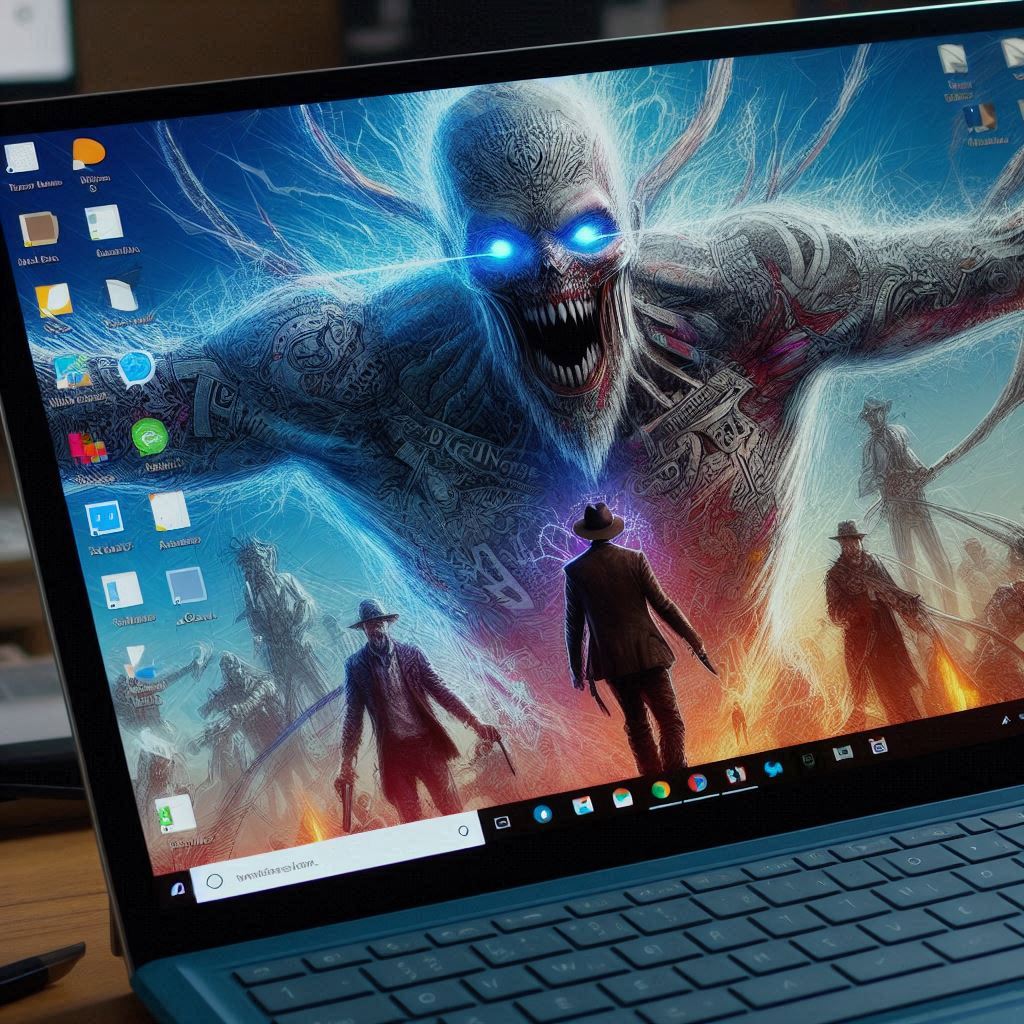
The Microsoft Surface Pro 4, released in 2015, is a versatile 2-in-1 device praised for its portability and performance. However, a common issue reported by users is screen ghosting, where images or elements persist on the display after they should have disappeared (e.g., a browser window lingering after being closed). This article provides a comprehensive guide to understanding and addressing screen ghosting on the Surface Pro 4, incorporating insights from user reports, technical analyses, and Microsoft’s responses as of 2025. It also draws on relevant web sources to offer actionable solutions and context for this persistent hardware issue.
Understanding Screen Ghosting on the Surface Pro 4
Screen ghosting is a display issue where a faint, residual image remains on the screen, often accompanied by flickering, shaking, or distorted visuals. On the Surface Pro 4, ghosting may manifest as:
- Persistent images: Previous content (e.g., a browser or taskbar) remains visible after closing or switching apps.
- Vertical smudges or lines: Light-yellow or gray lines, often on the screen’s edges, that appear intermittently.
- Overlapping visuals: Content from one part of the screen mirrors or duplicates elsewhere, such as the top address bar appearing in the taskbar.
These symptoms are often linked to the broader “Flickergate” issue, a term coined by Surface Pro 4 users to describe screen-related problems like flickering, scrambling, and ghosting. Ghosting is particularly frustrating for daily users, such as students or professionals, as it disrupts productivity and usability.
Common Triggers
- Overheating: Heavy workloads (e.g., video editing, gaming) cause the device to heat up, exacerbating ghosting.
- Hardware Wear: Aging components, especially the display or N-Trig touch controller, degrade over time.
- Environmental Factors: Temperature extremes or poor ventilation may worsen symptoms.
- Touchscreen Issues: Ghost touches (unintended inputs) often accompany ghosting, suggesting a faulty touch controller.
Causes of Screen Ghosting
Based on user reports and technical analyses, screen ghosting on the Surface Pro 4 is primarily a hardware issue, though software conflicts can contribute in rare cases. Key causes include:
1. Display Hardware Degradation surface pro 4 screen ghosting
- Aging Screens: The Surface Pro 4, now a decade old in 2025, uses LCD displays (Samsung or LG models) that degrade over time. Prolonged heat exposure from intensive tasks (e.g., video rendering at 72°C) weakens the display’s ability to refresh properly, causing ghosting.
- N-Trig Touch Controller: The N-Trig digitizer, responsible for touchscreen functionality, requires precise grounding to the display via conductive adhesive. If improperly connected or degraded, it can cause ghosting and ghost touches.
- Loose or Faulty Cables: Internal display cables may loosen over time, leading to intermittent ghosting or flickering.
2. Overheating
- Thermal Stress: Heavy usage (e.g., Zoom meetings, gaming) causes the CPU and back of the device to overheat, triggering ghosting. Users report symptoms worsening after 1–4 hours of intensive use.
- Degraded Thermal Paste: The thermal paste on the CPU breaks down over time, reducing cooling efficiency and contributing to display issues.
3. Software and Driver Conflicts
- Display Drivers: Outdated or buggy Intel HD Graphics drivers can cause visual artifacts, though this is less common for ghosting than for flickering.
- Adaptive Features: Features like Adaptive Brightness and Contrast, which adjust the screen based on content or ambient light, may misfire and cause ghosting-like effects.
- Firmware Updates: Some users report ghosting after specific firmware updates (e.g., April 2020 update), though Microsoft claims these issues are hardware-related.
4. Environmental Factors
- Temperature Sensitivity: Ghosting may worsen in cold or hot environments. One user noted that moving the device to a warmer area (e.g., poolside) temporarily resolved the issue, while cold server rooms exacerbated it.
- Magnet Interference: Nearby magnetic fields can interfere with the display, though this is rare.
Microsoft’s Response and the “Flickergate” Controversy
The surface pro 4 screen ghosting Surface Pro 4’s screen issues, including ghosting, are part of the broader “Flickergate” problem, widely documented by users on forums like Reddit and Microsoft’s support pages. Microsoft acknowledged a hardware-related “screen scramble” issue (distinct from flickering) and launched a replacement program in 2018, offering free replacements for eligible devices within three years of purchase. However:
- Eligibility: Only Surface Pro 4 devices with confirmed scrambling qualify, and the program excludes devices damaged by external factors (e.g., drops, liquid exposure) or repaired by third parties.
- Time Limit: As of 2025, most devices are outside the three-year window, leaving users to pay $450+ for out-of-warranty replacements, often with refurbished units that may develop the same issue.
- User Frustration: Over 2,000 users reported issues on Microsoft’s forums, criticizing the company for not extending the program or addressing the defect as a manufacturing flaw. Consumer Reports withdrew its buy recommendation for Surface devices due to reliability concerns.
Microsoft’s official stance is that ghosting and scrambling are hardware defects not fixable via software updates or firmware.
Solutions to Fix Surface Pro 4 Screen Ghosting
While surface pro 4 screen ghosting ghosting is often hardware-related, several troubleshooting steps can mitigate or confirm the issue. Below are practical solutions, starting with simple fixes and progressing to advanced options.
1. Basic Troubleshooting
- Reboot the Device:
- Restart via Start > Power > Restart or force a shutdown by holding the power button for 20 seconds. This refreshes the system and may temporarily resolve software-related ghosting.
- Check for Overheating:
- Ensure proper ventilation by placing the device in an open area, away from soft surfaces or cases that trap heat.
- Monitor CPU temperature using tools like Core Temp. If it exceeds 70°C, reduce workload (e.g., close heavy apps like video editors).
- Disable Adaptive Features:
- Adaptive Brightness: Go to Start > Settings > System > Display and uncheck “Change brightness automatically when lighting changes.”
- Adaptive Contrast: In the same menu, select Brightness and disable content-based adjustments. These features can cause ghosting-like effects under certain conditions.
- Lower Screen Brightness:
- Reduce brightness via Settings > System > Display to alleviate strain on the display.
- Check for Magnetic Interference:
- Remove magnetic accessories (e.g., Surface Pen, keyboard) and keep the device away from magnets or electronics.
2. Update Software and Drivers
- Install Windows and Surface Updates:
- Go to Settings > Windows Update > Check for updates to ensure the latest firmware and OS updates are installed. Microsoft’s updates may address minor driver issues.
- Update Display Drivers:
- Open Device Manager, expand Display adapters, right-click Intel HD Graphics, and select Update driver. If no updates are found, download the latest drivers from Intel’s website or use a tool like Driver Easy.
- Roll Back Drivers:
- If ghosting started after a driver update, roll back to an older version via Device Manager > Display adapters > Intel HD Graphics > Properties > Driver > Roll Back Driver.
- Run System File Checker:
- Open Command Prompt as administrator, type sfc /scannow, and press Enter to repair corrupted system files that may contribute to display issues.
3. Test in Safe Mode or UEFI
- Safe Mode:
- Boot into Safe Mode to isolate software conflicts:
- Hold the power button for 10 seconds to turn off.
- Repeat twice, then turn on again.
- Select Advanced options > Troubleshoot > Advanced options > Startup Settings > Restart.
- Press F5 for Safe Mode with Networking.
- If ghosting stops, a software conflict is likely. Uninstall recent apps or updates.
- Boot into Safe Mode to isolate software conflicts:
- UEFI Environment:
- Boot into UEFI via Settings > Update & Security > Recovery > Advanced startup > Restart now > UEFI Firmware Settings.
- If ghosting persists in UEFI, it’s a hardware issue, as UEFI bypasses Windows drivers. Contact Microsoft for replacement options.
4. Hardware Fixes
- Cooling Hacks:
- Place a small USB fan near the device’s back to reduce heat. Users report this reduces ghosting significantly.
- Avoid bizarre fixes like placing the device in a freezer, as this is temporary and risks damage (e.g., condensation).
- Replace Thermal Paste:
- If comfortable with hardware repairs, remove the display (using a heat gun and plastic cards) and replace the CPU’s thermal paste to improve cooling. This requires precision to avoid damaging the screen.
- Follow iFixit’s guide: [Surface Pro 4 Screen Replacement](https://www.ifixit.com/Guide/Microsoft+Surface+Pro Український+Screen+Replacement/60348).
- Screen Replacement:
- Replace the display with a Surface Pro 5 (SP5) screen, available for ~$140 on Amazon (2024 prices). The SP5 screen is compatible and less prone to ghosting, but ensure proper N-Trig grounding to avoid touch issues.
- Note: Replacing the screen is challenging due to adhesive; professional repair may cost $200–$400.
- Check N-Trig Connection:
- If replacing the screen, ensure the N-Trig touch controller is properly grounded with conductive adhesive or tin foil to prevent ghost touches and ghosting.
5. Workarounds for Continued Use
- External Monitor:
- Connect to an external monitor via mini-HDMI or a Surface Dock. Ghosting only affects the internal display, so this is a viable long-term solution.
- Reduce Workload:
- Lower power settings to “Balanced” or “Power Saver” via Control Panel > Power Options to minimize heat.
- Limit open apps/tabs to reduce CPU strain.
- Disable Touchscreen:
- If ghost touches accompany ghosting, disable the touchscreen in Device Manager > Human Interface Devices > Intel(R) Precise Touch Device. This may resolve usability issues but disables touch functionality.
6. Contact Microsoft Support
- Check Replacement Eligibility:
- Visit support.microsoft.com/devices to create a service order. If within three years of purchase (unlikely in 2025), you may qualify for a free replacement.
- For out-of-warranty devices, expect a $450+ fee for a refurbished unit, with only a 3-month warranty.
- Refund for Past Repairs:
- If you paid for an out-of-warranty repair for screen scrambling, contact support for a potential refund.
- Global Support:
- Use Microsoft’s global support numbers or online chat. In Australia/New Zealand, check consumer law rights for additional remedies.
Limitations and Considerations
- Age of Device: Most Surface Pro 4s are 9–10 years old in 2025, making hardware degradation likely. Replacement parts may be hard to source.
- Cost vs. Value: Repair costs ($200–$450) may approach the price of a new budget laptop, so weigh the device’s sentimental or functional value.
- Temporary Fixes: Cooling hacks or software tweaks may delay but not eliminate ghosting.
- Risk of DIY Repairs: Screen replacement or thermal paste application risks further damage (e.g., cracked display). Proceed with caution or seek professional help.
Community Insights and Sentiment (2025)
User posts on platforms like Reddit and Microsoft forums reveal widespread frustration with Surface Pro 4 screen issues:
- Reddit Feedback: Users report ghosting after heavy use or charging, often linked to overheating. Some successfully replaced screens with SP5 panels, but others faced recurring issues.
- Flickergate Advocacy: The Flickergate website (2017–2018) documented 2,000+ complaints, urging Microsoft to acknowledge the defect. Users criticized the short warranty extension and high repair costs.
- Workarounds: External monitors and cooling fans are popular, but many users replaced their devices due to persistent issues.
No recent X posts (July 2025) specifically address Surface Pro 4 ghosting, indicating the issue is less discussed as users move to newer devices.–
Conclusion
surface pro 4 screen ghosting Screen ghosting on the Surface Pro 4 is primarily a hardware issue caused by aging displays, overheating, or faulty N-Trig connections, often linked to the “Flickergate” defect. While software tweaks (e.g., updating drivers, disabling adaptive features) may help, most cases require hardware intervention, such as cooling hacks, thermal paste replacement, or a new SP5 screen. External monitors offer a reliable workaround, but repair costs may outweigh the device’s value in 2025. For persistent issues, contact Microsoft support to explore replacement options, though eligibility is limited. If budget allows, consider upgrading to a newer device, as the Surface Pro 4’s age makes long-term fixes challenging.


